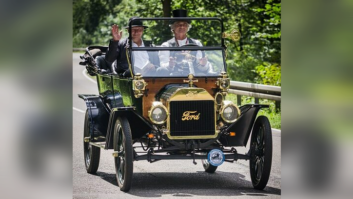Radio broadcasters worldwide have noticed the increasing use of smart speakers to listen to audio content, in particular terrestrial radio, where a recent Jacobs Media survey (October 2018) indicates that AM and FM radio are the third most listened-to category on smart speakers in the US.

Smart speakers offer a way for broadcasters to engage younger audiences with content that is traditionally carried by linear, over-the-air radio services. However, all smart speaker devices currently utilize streaming delivery and lack the ability to receive over-the-air content from broadcast services, thus losing the principal advantages of over-the-air delivery.
The EBU and the NAB recently collaborated on the development of a prototype device to enable over-the-air radio broadcasting with smart speakers.
COLLABORATION
This “voice-controlled radio,” unveiled at both IBC in Amsterdam and the Radio Show in Orlando, has shown that over-the-air reception can play a central role in the success of radio listening on smart speakers. This collaboration exemplifies radio as a global platform and how broadcasters can work together to promote listener engagement on new platforms.
Amazon Alexa and Google Home devices have captured a large part of the smart speaker market and they rely on an active IP connection to stream radio services. While broadcasters have benefited from this listening, the use case can be improved by enabling reception of the over-the-air signal.
Smart speaker ownership continues to grow around the world. Further, this voice assistant technology is expanding into areas outside of the home including into automobiles from most car manufacturers. Making radio easy to discover and receive via smart speakers and voice assistants is an important part of the future of broadcasting. This technology will be an important platform for engaging with younger audiences, and important for ensuring a bright future for terrestrial radio.
Digital or analog terrestrial broadcast is still the most effective way to deliver linear audio content to mass audiences as discussed in this EBU publication: https://tech.ebu.ch/publications/tr_2017_radio. This is true both in terms of pure economics and in terms of obligations of coverage. Hybrid radio, combining over-the-air broadcast and an IP connection, blends the best of both, enabling reliable audio alongside additional content and features such as personalization. For broadcasters to reliably and consistently reach their audience, device support for over-the-air terrestrial reception remains key.
The voice-controlled radio prototype developed by NAB and EBU demonstrates how existing voice assistants such as Amazon Alexa and Google Assistant can be utilized to make smart decisions about the best way to listen to a radio station’s content. The technology can apply the voice commands of a listener to determine whether to use over-the-air or streaming to tune the station based on broadcaster parameters (those sent in FM, DAB+ and HD Radio broadcasts) along with available hardware in the device. Using voice recognition to access a broadcast signal for audio enables radio services to better scale onto these new platforms and enable a path to future innovative services.
HOW IT WORKS
When a user asks for a radio service by its name, the voice-controlled radio attempts to fetch the audio over an IP connection by obtaining its stream address, as its default behavior. To enable the use of over-the-air instead of IP, the device already knows about all of the available local broadcast services. By performing a hybrid radio lookup (using RadioDNS) the voice-controlled radio locates additional openly-standardized metadata from the broadcaster, including all the different ways to listen to their services. By linking the fetched stream address to available broadcast services, it is then able to activate its over-the-air broadcast hardware to receive the service, instead of needing to always open an IP connection.
The EBU’s head of radio, Graham Dixon, welcomed the joint project, saying that “Voice-activated devices, smart speakers are entering our lives at a remarkable speed. Many people find them attractive and useful companions. This means a new opportunity for broadcasters and also new challenges. For this reason, I strongly welcome this collaborative initiative to explore the interface between voice and broadcast. It helps envisage new flexible ways of distribution, refreshing the radio experience with the latest technology.”
NAB Executive Vice President and Chief Technology Officer Sam Matheny said: “Voice control and smart speakers are experiencing tremendous growth in popularity, and this prototype effort demonstrates how hybrid radio and OTA delivery can be a part of this evolution. We are delighted to partner with our friends at the EBU on this collaboration and we believe it can benefit broadcasters around the globe.”
With success, PILOT and the EBU intend to release the proof of concept code on a royalty-free basis to manufacturers for use in production implementations of voice assistant devices and to further kickstart its deployment.
For more information, contact David Layer at NAB ([email protected]) or Ben Poor at EBU ([email protected]).
Comment on this or any story. Email [email protected].







